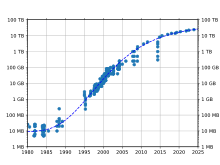Using rigid disks and sealing the unit allows much tighter tolerances than in a floppy disk drive. Consequently, hard disk drives can store much more data than floppy disk drives and can access and transmit them faster.
- As of April 2010, the highest capacity consumer HDDs are 2 TB.[18]
- A typical "desktop HDD" stores between 120 GB and 2 TB (although rarely above 500 GB of data based on US market data[19]), rotates at 5,400 to 15,000 rpm, and has a media transfer rate of 0.5 Gbit/s or higher. (1 GB = 109 Byte; 1 Gbit/s = 109 bit/s)
- The fastest “enterprise” HDDs spin at 10,000 or 15,000 rpm, and can achieve sequential media transfer speeds above 1.6 Gbit/s.[20] and a sustained transfer rate up to 1 Gbit/s.[20] Drives running at 10,000 or 15,000 rpm use smaller platters to mitigate increased power requirements (as they have less air drag) and therefore generally have lower capacity than the highest capacity desktop drives.
- "Mobile HDDs", i.e., laptop HDDs, which are physically smaller than their desktop and enterprise counterparts, tend to be slower and have lower capacity. A typical mobile HDD spins at either 4200 rpm, 5400 rpm, or 7200 rpm, with 5400 rpm being the most prominent. 7200 rpm drives tend to be more expensive and have smaller capacities, while 4200 rpm models usually have very high storage capacities. Because of physically smaller platter(s), mobile HDDs generally have lower capacity than their larger desktop counterparts.
The exponential increases in disk space and data access speeds of HDDs have enabled the commercial viability of consumer products that require large storage capacities, such as digital video recorders and digital audio players.[21] In addition, the availability of vast amounts of cheap storage has made viable a variety of web-based services with extraordinary capacity requirements, such as free-of-charge web search, web archiving and video sharing (Google, Internet Archive, YouTube, etc.).
The main way to decrease access time is to increase rotational speed, thus reducing rotational delay, while the main way to increase throughput and storage capacity is to increase areal density. Based on historic trends, analysts predict a future growth in HDD bit density (and therefore capacity) of about 40% per year.[22]Access times have not kept up with throughput increases, which themselves have not kept up with growth in storage capacity.
The expected random IOPS capability of any HDD can be calculated by dividing 1000 msecs by the sum of the average seek time and the average rotational latency.
The first 3.5″ HDD marketed as able to store 1 TB was the Hitachi Deskstar 7K1000. It contains five platters at approximately 200 GB each, providing 1 TB (935.5 GiB) of usable space;[23] note the difference between its capacity in decimal units (1 TB = 1012 bytes) and binary units (1 TiB = 1024 GiB = 240 bytes). Hitachi has since been joined by Samsung (Samsung SpinPoint F1, which has 3 × 334 GB platters), Seagate and Western Digital in the 1 TB drive market.[24][25]
In September 2009, Showa Denko announced capacity improvements in platters that they manufacture for HDD makers. A single 2.5" platter is able to hold 334 GB worth of data, and preliminary results for 3.5" indicate a 750 GB per platter capacity.[26]


No comments:
Post a Comment